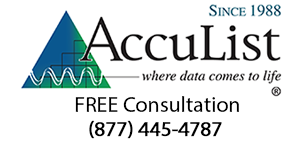Corporate Gift Marketers, Buyers Ready for Year-End Holiday Push
Corporate holiday gift-giving lies ahead, and AccuLIst’s clients offering food and wine gifts and promotional products designed to clinch customer loyalty are gearing up for a key business-to-business marketing season. So what are major factors affecting corporate gift-giving in 2019?
Meeting and Exceeding Expectations
Corporate gift buyers and gift marketers will want to keep in mind some of the essential factors that affect gift satisfaction, as cited in a recent The Balance Small Business blog. To generate the desired client response, corporate gift givers should keep in mind 1) organizational policies, which may limit the dollar value of gifts or even prohibit gifts; 2) the personal preferences and needs of the recipient (note that today’s customer expectations of personalization apply); 3) any cultural/local differences (for example, a white-wrapped gift may not be well-received in Asia where white is the color of death); 4) the perceived quality of the gift and its packaging (although gift value should be proportional to client value so that a $200-a-year client doesn’t get a $300 gift); 5) today’s preference for a personal touch, such as a handwritten note or in-person delivery; and 6) IRS deductions (business gifts in the U.S. are tax deductible up to $25 per person for the tax year, although rules differ by business structure). What type of gift will meet most businesses’ requirements? The American Express Semi-Annual Small Business Monitor survey found that today’s top corporate gifts include cards or calendars (49%); gift certificates for retail or restaurants (26%); company-branded items (23%); a fruit/food basket (18%); a charity donation (18%); flowers/plants (10%); and wine/liquor (10%).
Value and Personalization Score with Clients
For more ideas, check out a 2019 Hubspot article listing more than 20 gifts rated as likely to keep clients thinking positively about a company throughout the year. Most fell within the general categories noted above, but here are the more specific descriptions for added inspiration: a terrarium or succulent garden; professional notebooks; coffee or tea blend packages; calendars; a coffee table book; a toiletry bag for travel; a gourmet food basket; a portable phone charger; a K-Cup coffee sampler; a Kindle e-reader; a custom-quality water bottle; online classes; a BarkBox gift for a pet owner; a charity donation; a beer brewing kit; quality clothing with a subtle logo; a restaurant gift card; a bakery delivery; a cook’s basket; a catered lunch; custom balls and tees for the golfer; and headphones. Note that six gifts involve a food and/or beverage basket. In choosing that basket, gift buyers may want to consider the 2019 ratings just out from Top Ten Reviews.
Top-Rated Gift Baskets for 2019
AccuList’s client Wine Country Gift Baskets once again ranked high with Top Ten Reviews for 2019. The reviewers tested baskets from the top 11 gift basket companies for taste, presentation, pricing/value, payment and delivery, customer support, number of basket types and special options (such as Kosher). Harry & David’s Founders’ Favorite Gift Box was rated “best overall,” while Wine Country Gift Baskets’ Gourmet Choice Gift Basket received “best value” for the amount and selection of foods for the price. For foodies, igourmet.com’s California Classic Gift Box was rated as “best for food connoisseurs.” To really personalize to individual tastes, the Design It Yourself company lived up to its name and was ranked as the “most personalized” option, while Gourmet Gift Baskets impressed among alcohol-themed hampers. Read more details on all gift basket ratings.
Facebook Both Boosts and Challenges Fundraising Efforts
AccuList helps its nonprofit clients with fundraising via direct mail and events as well as digital channels, and online giving certainly has seen tremendous growth in recent years. But the latest M+R Benchmarks report shows a distinct slowdown in nonprofit online revenue. After years of steady growth (a 23% increase in 2017), online fundraisers reported just 1% growth in 2018. Exploring the why behind that drop yields some important lessons for fundraisers moving forward, especially when it comes to Facebook campaigns.
Facebook Changes the Game, But Are Nonprofits Ready?
M+R cites multiple trends underlying lower online revenue growth—from declining e-mail response, to more low-dollar mobile traffic, to falling online donor retention. But the report starts by noting how rising Facebook usage has both undercut revenue measures and signaled potential for future growth. Yes, changes to the Facebook algorithm resulted in, on average, only 7% of followers seeing any given post, but use of Facebook Fundraisers’ peer-to-peer giving really took hold for the first time in 2018. However, because of the way the donations are processed, the Facebook Fundraiser dollars were not included in M+R online revenue calculations. It’s an important missing piece for revenue growth: The Facebook Fundraiser tool for hosted fundraising now accounts for about 99% of all nonprofit revenue processed on Facebook, with nonprofits raising $1.77 through Facebook for every $100 raised through other online channels, per M+R. The impact is big for some sectors. For example, health nonprofits received $29.88 from Facebook for every $100 in direct online revenue in 2018, accounting for about 30% as much revenue as every other source of online revenue, including e-mail, web giving, monthly donors, digital ads, and search. To turn the new Facebook Fundraiser use into a bigger revenue boon, notes the M+R report, nonprofits would need to make an effort to get more individuals (the average now is 56) involved in hosting fundraisers and in attracting both more donors and higher-dollar donors (now the average per hosted fundraiser is seven donors and a modest $31 gift per donor).
Ignorance of ROI Is Far From Bliss
Another recent study pointed to a deeper issue with nonprofit Facebook efforts. The 2019 Digital Outlook Report—from care2, hjc and nten—found that nonprofits surveyed reported spending anywhere from $0 to $100,000 on Facebook and Instagram campaigns. But the majority (over 75%) answered “don’t know” when asked about any resulting revenue! Clearly, the report urges, staff need training in analytics, whether using Google or another tool, as well as calculating not only resulting donations but the value of lead generation, e-mail signups, event attendance, etc. If there is any good news from this kind of ROI blindness, it is that Facebook probably has untapped potential.
Tips for Optimizing Facebook Fundraising
CauseMic recently offered some helpful tips for fundraising with Facebook. In using Facebook Fundraiser, in order to benefit from site traffic and donor information as well as dollars, start by disabling the “donate” button and direct supporters to donate on your website rather than through Facebook. Donors will learn more about the mission and fundraisers can stay connected with them for better retention. Second, nonprofits shouldn’t focus only on the Facebook tool hosting fundraisers; they can use promoted posts and ads to grow the support base, interact with supporters, promote events, etc. When a breaking news story or emergency occurs that impacts giving, it can be incorporated into social media outreach to spread the word and raise money more quickly. Just make sure to use tracking analytics and calculate result values to avoid the ROI ignorance identified in the Digital Outlook Report noted above! Plus, make sure that Facebook is a consistent piece of a multi-channel strategy, and remember that it offers a proven response driver to multi-channel campaigns: video. Use the platform to post videos about donation impact, to host live videos, to publicize upcoming events, and to tell the organization’s story with visual/emotional resonance. Finally, pay attention to timing in planned Facebook campaigns; M+R found that nearly a quarter of all Facebook revenue is raised in the month of November.
For more on general trends in online fundraising, see the latest M+R Benchmarks.



